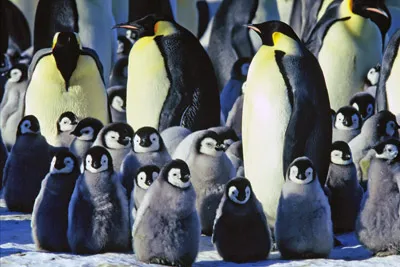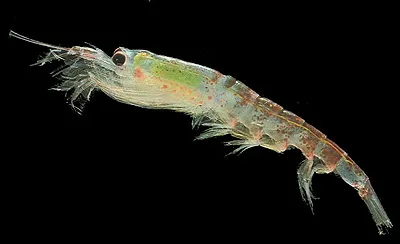What's it like in Antarctica - simplified
It's cold, but you guessed that already, it's also the highest and windiest continent. What are the details and other than this, how cold is it really and why is it like this?
Where is Antarctica? How big is Antarctica?
Antarctica is the fifth largest of the seven continents. It's an enormous place, nearly 14.2 million square kilometers (about 5.5 million square miles). This is about twice the size of Australia, one and a half times as big the USA and fifty times the size of the UK.
It includes the South Pole. Most of it is inside the Antarctic Circle.
Antarctica is a very rough circle shape, the long arm of the Antarctic Peninsula stretches towards South America.

There are two large seas that eat into the circle. These are the Ross Sea and the Weddell Sea.
The nearest other land is:
- South America - 600 miles / 1000 km away
- Australia - 1550 miles / 2500 km away
- South Africa - 2500 miles / 4000 km away
In the winter Antarctica doubles in size because sea ice builds up around the coast.
Why is Antarctica so cold?
1/ Sunlight
strikes the earth straight on (at a right angle) at the equator
and then at more of an angle gets as you move away from the
equator towards the poles.
This means that at
the poles the sunlight and heat is spread out more. The tilt
of the earth as the seasons go by make an even bigger difference
in the winter.
2/ Temperature falls as you gain height at the rate of about 1C per 100m. Antarctica is the highest continent with at an average of 2,300m / 7,546 ft or 1.4 miles.
3/ Antarctica is a large land mass. Other than at the coasts it is not warmed by the sea.
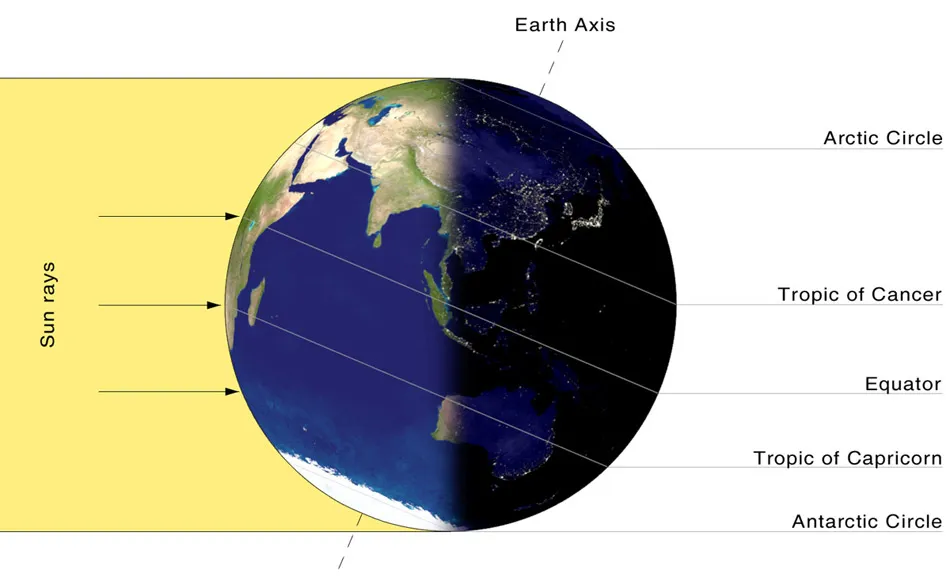
Antarctica in midsummer,
the heat and light from the sun is spread over a larger area
the closer you get to the poles, compared to the equator where
the same amount of energy is less spread out.
Antarctica is so cold
because it is at the pole,
is very high and is a large landmass.
Why is Antarctica colder than the Arctic?
The North Pole (Arctic) is a sea surrounded by land, and the South Pole (Antarctica) is an area of land surrounded by sea. Antarctica is colder than the Arctic for three main reasons.
1/ The North Pole is warmer is because of the sea. Sea water doesn't get below -2C without freezing, so the sea acts like a sort of (pretty cold) big warm thing.
The Antarctic on the other hand has rock under it which gets as cold as you like so the temperature drops and drops - it acts like a big cold thing.
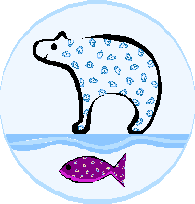 2/
Antarctica is covered with a thick ice sheet. The South
Pole is 2,385m above sea level. Antarctica on average is 2,300m
high and the highest point is about 4,000m.
2/
Antarctica is covered with a thick ice sheet. The South
Pole is 2,385m above sea level. Antarctica on average is 2,300m
high and the highest point is about 4,000m.
The North Pole by comparison is at a maximum altitude of just a few meters above sea level - and that's when a large lump of ice is floating by.
3/ Antarctica is isolated far from other places on earth. It is separate from the rest of the world's weather in a way that the Arctic isn't. The Arctic gets warmer air from nearby places like Canada and Russia. Sometimes warm air from the tropics can make it up to the Arctic.
This doesn't happen in Antarctica. It has its own weather systems that rush round and round the continent having nothing to do with the rest of the world.
Why is Antarctica considered to be a desert?
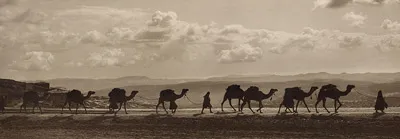 A
Desert* is a place with less than 254 mm (10 in) of annual rainfall.
A
Desert* is a place with less than 254 mm (10 in) of annual rainfall.
There is almost no rain in Antarctica - it is so cold it only ever snows.
Snow fall is measured in "water equivalent". This is the amount of water you would get if the snow was collected and melted to make water.
Antarctica gets only about 50 mm of "water equivalent" per year, this is less than the Sahara. There is more near the coasts but still only about 200 mm a year, below the 254mm level for a desert.
The big difference in Antarctica is that unlike other deserts falling water (snow) doesn't dry up and disappear, so small amounts of snow falling build up over hundreds and thousands of years into enormously thick ice sheets.
* As opposed to a "dessert" - something sweet and tasty at the end of a meal!
What is the climate like? How cold does it get in Antarctica?
Antarctica is the coldest, and also the windiest continent.
The lowest temperature ever on earth, -89.2° C (-128.6° F) was on July 21st 1983 at the Russian Vostok base. This base is near to the "Pole of Inaccessibility", the place on Antarctica that is the furthest from the sea in all directions.
Being near to the sea means that temperatures don't usually get really low. Being far from the sea means that temperatures can get especially cold.
Antarctica also gets really strong winds. The wind is almost always blowing. If it stops it will only be for a short time of a few hours.
A wind speed of 320 km/h (200 mph) was recorded at a French base in July 1972.

There are three climate regions in Antarctica.
-
The interior of the continent is very cold with little snowfall.
-
The coast has warmer temperatures (though still cold) and much higher snow fall (but still not a lot).
-
The Antarctic Peninsula region which has a warmer and wetter climate, with above-freezing temperatures sometimes.
|
Whiteout in Antarctica |
Even though it doesn't actually snow that often it, seems that more snow is falling than there really is because the constant winds pick up snow that has already fallen and blow it around.
This can lead to a blizzard and white-outs - when everything looks white with blowing snow and you can't even see someone standing next to you. - like being inside a big ping pong ball.
What is the Antarctic landscape like?
Antarctica is made up of of two main areas. East Antarctica and smaller West Antarctica which also has the Antarctic Peninsula.
West Antarctica is a continuation of the Andes mountain range stretching from South America they then become the Transantarctic Mountains which almost go through the middle but miss the South Pole. If the ice sheet was taken away, West Antarctica would actually be a lots of islands.
 Part
of the Transantarctic Mountains
Part
of the Transantarctic Mountains
More than 99 percent of Antarctica is covered with ice. This is about 70 percent of the world's fresh water. All that ice makes it the highest continent an average of about 2,300 m (7,500 ft) above sea level.
The tallest point in Antarctica is the 'Vinson Massif' at 4,897 m (16,066 feet) above sea level.
The lowest point is the 'Bentley Subglacial Trench' 2,499 m / 8,200 ft below sea level, this is a trench in the surface of the earth covered with more than 3,000 m (9,840 ft) of ice and snow.
|
|
The Antarctic Ice Sheet is not smooth and flat. Gravity makes it constantly flow very slowly towards the coast. At the coast it may start to float while still attached and form an ice shelf.
The largest ice shelf, the Ross Ice Shelf, is the size of France. Ice shelves make the largest icebergs known as tabular bergs because they're flat on top...like tables.
The ice sheet can be very dangerous because it has cracks up to hundreds of feet deep called crevasses, these can be covered by weak bridges formed of blown snow.
In places, you may see a "Nunatak" a rock that is the top of a mountain peeking up through the ice sheet. Nunataks can make a home for birds like snow petrels. They can build their nests here even though there is nothing for miles and miles around except ice.

Nunataks are very useful to geologists (scientists who study rocks) as they can show what the rock is like in that area even if it is mostly buried by thick ice.
There are at least two active volcanoes in Antarctica. Mount Erebus (3,794 m / 12,448 ft) is the highest and has a permanent molten lava lake. The other is on Deception Island, a place where many tourist ships stop off. You can even have a warm bath there heated by the lava, with snow, ice and even penguins around you.
Some people think that there might more volcanoes under the ice sheet. In some places glaciers and ice rivers are flowing very quickly which might be because the heat from the volcano is melting the bottom of the ice and making them slide faster.
What kinds of plants and animals are there in Antarctica?
Antarctica has no trees or bushes at all. There are only about 350 kinds of plants (many places in the world have thousands), and most of them are moss or algae. The Peninsula has more plants than most of Antarctica.
In some places rocks are covered in the vibrant red, orange and yellow growth of lichens. Where the ice melts off of the rocks in summer, green lichens that grow to a few centimeters high can look like a field of rough, low grass. Only three plants with flowers are found in Antarctica.
Lichens have been found growing on mountains within 475 km (295 miles) of the South Pole surrounded by a vast sea of ice.
 An endolith, the green band is
algae
An endolith, the green band is
algae
growing inside thiscracked open rock
In a place called the Dry Valleys some algae grows inside rocks rather than than on them because even though very little light gets through the winds are so cold and strong that the algae does better inside than out where it would be brighter but more exposed.
There are no animals in Antarctica that live on land and have a backbone (vertebrates). All the vertebrates either live in the sea or leave the land in the winter being summer visitors only.
The largest truly Antarctic land animals are invertebrates (no backbone) and are tiny, a few millimeters in size. These animals, mites, ticks and worms survive the cold of winter under rocks, they have antifreeze in their bodies which protects them. They don't move for weeks or even months sometimes. They become active and mobile again when it gets warmer and the ice melts.
The oceans around Antarctica are full of life. Lots of whales feed on the rich food supply there, especially krill (small animals like shrimps or prawns). Six different types of seals and 12 types of birds live in the Antarctic. If you added up all of the krill it would weigh more than all of the humans in the world.
The most famous animals to live in Antarctica are penguins. They can't fly but are excellent swimmers, penguins live on ice and in the oceans around Antarctica. They breed on the land or ice along the coast and on islands.
Who lives there?
Antarctica doesn't have any native people whose ancestors come from there.*
It was the first and only continent that was "discovered". Other continents already had plenty of people there before any "explorers" arrived.
No-one had ever even seen Antarctica before 1820.
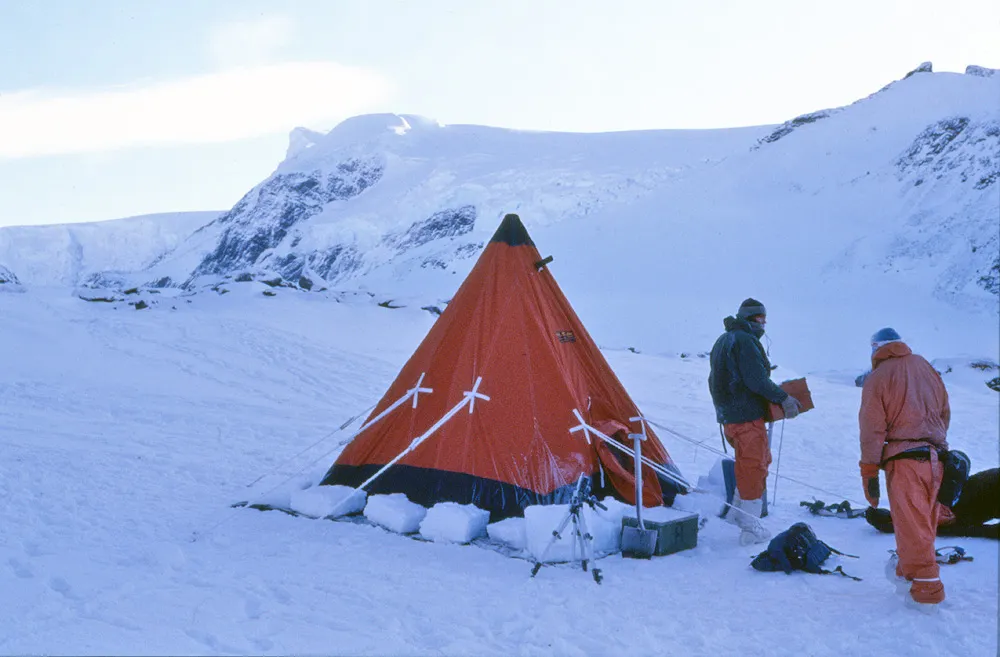
Early explorers and then later on, whalers and sealers were the first people to ever see Antarctica. Through the 20th century many countries built scientific bases there.
A mixture of scientists and support staff spend anywhere from a few months to a couple of years before leaving. As they leave a new group of scientists and support staff arrive.
New bases are opened and some old ones close down. Some have drifted away to sea as they were built ice shelves which broke off and became an iceberg.
The answer to the question "Who lives there" is "no-one". Antarctica is occupied by visitors only. Thousands in the summer and hundreds in the winter. Many of them on various scientific bases but also lots of tourists in the summer.
*Some babies have been born on Antarctic bases (11 so far) but only as part of political attempts to strengthen national claims, they are not true "Native Antarcticans".
What is the Antarctic convergence?
The Antarctic Convergence marks the true outer edge of Antarctica. It is a strip of sea about 40 km or so across that goes all the way around the continent.
It's not always in exactly the same place, waving back and forwards by some kilometers over weeks and months.
The temperature of the sea at the surface changes by 2.8 - 5.5°C from one side of the convergence to the other - that's A LOT for the width. There are also changes in the chemicals in the sea water.
There is enough difference from one side to the other of the convergence to call the sea around Antarctica the "Southern" or "Antarctic" ocean. It is treated like a separate ocean and not just the most southerly part of the Atlantic, Indian and Pacific oceans.
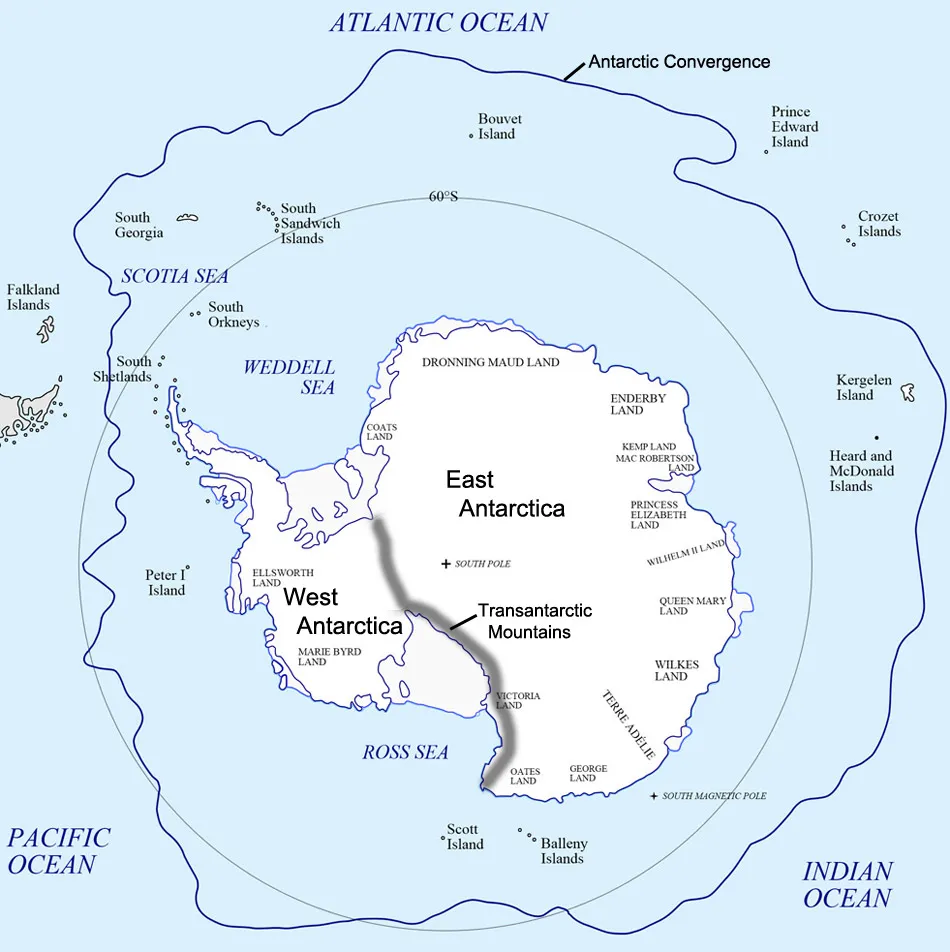
The Antarctic convergence has existed for about 20 million years. In all this time there has been little exchange of sea creatures from one side to the other. For instance, there are no virtually no decapod crustaceans, crabs, lobsters etc. in Antarctica, these are common any where else in the world's oceans - including the Arctic.
The convergence is a complicated and turbulent area. Sea water cools around the Antarctic continent and becomes heavier. This makes it sink and flow north along the sea bed in a deep ocean current. It meets deep, warmer, south-flowing water from the equator.
As the two meet, they rise to the surface in an upwelling carrying many dissolved nutrients. These act like a fertiliser for the southern ocean - and is the reason that the seas around Antarctica are so surprisingly rich in life in spite of the cold temperatures. It is this meeting, mixing and rising of two deep ocean currents that makes the Antarctic Convergence.
What natural resources does Antarctica have?
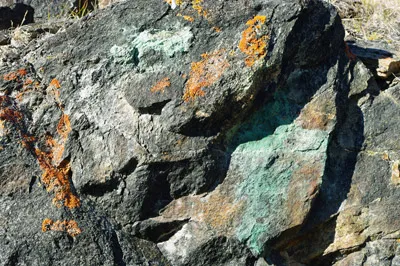 Copper minerals in rock
We can't be sure what
resources there are in Antarctica because it's covered in
lots and lots of ice.
Copper minerals in rock
We can't be sure what
resources there are in Antarctica because it's covered in
lots and lots of ice.
180 million years ago Antarctica was connected to South America, Asia, and even Australia. This makes some people think that there might be lots of minerals under the ice like there is in South America.
Coal and other minerals have been found in Antarctica and there might be oil and gas too but people aren't allowed to get it because lots of countries agreed to preserve Antarctica by an agreement they called the Antarctic Treaty.
If people wanted to mine in Antarctica they would find it very hard for several reasons:
- Antarctica is the coldest place in the world.
- It is covered in ice.
- There aren't any towns or cities for hundreds or
thousands of miles.
- The miners would have to sail through the roughest and
scariest seas in the world to get there.
- There are massive ice-bergs that weigh billions of tonnes.
- Every year the coasts around Antarctica freeze and only the biggest and most expensive ships can break the ice. Even they can't get everywhere in the summer and can get no-where at all in the winter.
 The
oil and gas might be obtained in the future because they are
in places not protected by the Antarctic Treaty.
The
oil and gas might be obtained in the future because they are
in places not protected by the Antarctic Treaty.Antarctica has lots of wildlife, whales, seals and penguins were hunted a lot in the past, this isn't allowed any more. Fishing is allowed as the Antarctic Treaty doesn't cover the seas, just the land. A lot of boats catch squid but this is one of the things the wildlife eat so it can affect them badly.
It was thought that krill (a type of shrimp) would be very useful for humans to eat, but it goes off very fast and tastes pretty awful.
Tourists go to Antarctica on cruises, this can cause damage to and pollution, some companies have even asked permission to build a hotel and even a casino, though these weren't allowed.
Even though tourists may cause some damage to Antarctica they could also help it by making people aware of it so leading to its protection when they learn what a fantastic place it is.
More on this: Conservation / Environment links,
Who owns Antarctica?
 In
the early decades of the 20th century (1900's) seven nations,
Argentina, Australia, Chile, France, New Zealand, Norway
and the United Kingdom claimed part of Antarctica.
In
the early decades of the 20th century (1900's) seven nations,
Argentina, Australia, Chile, France, New Zealand, Norway
and the United Kingdom claimed part of Antarctica.
Proper exploration and research of Antarctica began with the International Geophysical Year (IGY). July 1st 1957 to December 31st 1958.
35 scientific stations were built on Antarctica with another 15 on islands by 12 different nations during the IGY.
The IGY was such a success that international co-operation seemed worth carrying on. It was followed by another year of cooperation when the 12 nations (Argentina, Australia, Belgium, Chile, France, Japan, New Zealand, Norway, South Africa, USA, USSR and the United Kingdom) decided to continue their research.
People from all of these 12 countries met in Washington, D.C. in 1959 to draft and sign the Antarctic Treaty.
This treaty meant the entire continent was to be used for peaceful reasons. It came into effect in 1961 and all claims on land were put on hold. In 1991, 24 nations approved a protocol (addition) to the treaty that would ban oil and other mineral exploration for at least 50 years.
The answer to "Who owns Antarctica" is "No-one and everyone"
Picture credits, copyright pictures used with permission: Earth at Antarctic midsummer equinox diagram - Przemyslaw "Blueshade" Idzkiewicz Creative Commons Attribution ShareAlike 2.0 Generic License / Gentoo penguin clipart - Clip Art Queen / Map of Antarctica and the Southern Ocean - Hogweard, Creative Commons 3.0 Share and Share Alike Unported license


